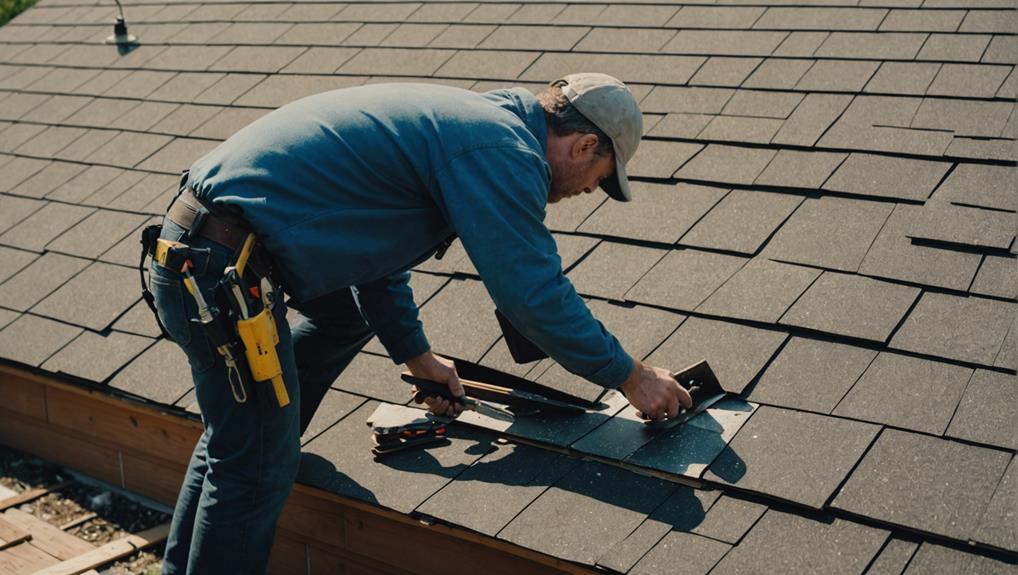Few issues in home maintenance can be as vexing as roofing problems. Roof Woes Exposed: Solutions Disclosed‘ sheds light on practical strategies to address these common headaches effectively. From the intricacies of small leaks to the importance of roof vent maintenance, this piece offers a glimpse into the world of professional roof care. With insights on key topics like chimney crickets and kick-out flashing, it promises to equip readers with valuable knowledge to navigate the complexities of roof maintenance.
Main Points
- Promptly address small leaks to prevent further damage.
- Use rubber-washer screws to secure roof vents effectively.
- Utilize roof cement for long-lasting repairs, not temporary fixes.
- Install chimney crickets to direct water away from chimneys.
- Implement kick-out flashing to safeguard roof edge junctions.
Small Leak Solutions
Prompt action is essential to address small leaks in a roof effectively to prevent further damage and deterioration.
When dealing with a small leak, inspect for flow stains on plastic vapor barriers or check for shiners on the underside of the roof. Moisture often condenses on cold nails in the attic, leading to frosted nails that can be clipped with side-cutting pliers.
Addressing minor stains promptly is vital to prevent the issue from escalating. By taking swift action and identifying the source of the leak, you can mitigate potential water damage and safeguard the longevity of your roof.
Roof Vent Fixes
Inspecting and repairing roof vents is essential for maintaining the integrity of your roofing system. Here are some crucial tips for fixing roof vents:
- Avoid Caulk: Refrain from using Caulk for cracked plastic or broken metal vents.
- Replace Damaged Vents: Opt to replace damaged vents with temporary fixes for long-term durability.
- Secure with Screws: Use rubber-washer screws to fasten the vents in place securely.
- Use Caulk Strategically: Utilize Caulk to anchor down shingles and create a reliable water barrier.
- Understanding Construction Cuts: Familiarize yourself with the significance of a birdsmouth cut in construction practices.
Roof Cement Tips
Utilizing roof cement effectively guarantees long-lasting and watertight repairs on your roof.
Avoiding roof cement as a temporary fix is essential, as heavy tar patchwork can make proper repairs challenging.
Addressing tar patchwork promptly is necessary to prevent interior damage and ensure the longevity of the repair.
Proper flashing work, including metal flashing, requires time and expertise to be effective.
Avoiding heavy tar patchwork and focusing on long-term solutions will help maintain the integrity of your roof and prevent potential water leaks.
Chimney Cricket Importance
Guaranteeing proper cricket installation is crucial for effective water management around wide chimneys. Crickets are small ridge structures designed to divert water on the roof, especially around protruding elements like chimneys.
Here are the key points highlighting the importance of chimney crickets:
- Prevents debris buildup behind wide chimneys, reducing the risk of rust and rot
- Directs water away from the chimney and off the roof surface
- It helps to maintain the integrity of flashing by reducing water accumulation
- Minimizes the chances of water leaks and subsequent interior damage
- It is essential for wide chimneys over 30 inches to ensure proper water drainage
Kick-Out Flashing Importance
Proper kick-out flashing installation is crucial for safeguarding roof edge and sidewall junctions against water infiltration. It plays an important role in directing water away from these vulnerable areas, preventing potential damage such as rot in sheathing and framing.
Water can seep into walls without kick-out flashing, leading to long-term structural issues. It is essential to address missing kick-out flashing promptly to avoid extensive repairs down the line. By adding kick-out flashing to the roof edge and sidewall junctions, homeowners can effectively protect their property from water damage and maintain the longevity of their roof system.
Installing kick-out flashing is a fundamental step in maintaining a watertight roofing system.
Chimney Flashing Best Practices
Effective chimney flashing installation is crucial for maintaining a watertight roofing system and preventing potential water intrusion. To guarantee the proper installation of chimney flashing, consider the following best practices:
- Use high-quality materials for longevity
- Install step flashing and counterflashing correctly
- Inspect flashing regularly for signs of wear or damage
- Avoid relying solely on Caulk or roof cement for sealing
- Seek professional assistance for complex flashing issues
Gutter Apron Installation
During a new shingle installation, incorporating a gutter apron is essential for preventing water damage and maintaining the integrity of the roof edge. A gutter apron is a protective barrier installed between the roof shingles and the gutter to prevent water from penetrating behind the gutter and causing damage to the fascia and soffit.
To install a gutter apron correctly, slip it under the existing shingles at the roof edge and secure it with roof cement. This simple addition helps direct water into the gutter system, preventing potential rot in the fascia and soffit.
Ensuring that a gutter apron is included during roof installation can significantly prolong the roof’s life and prevent costly repairs.


